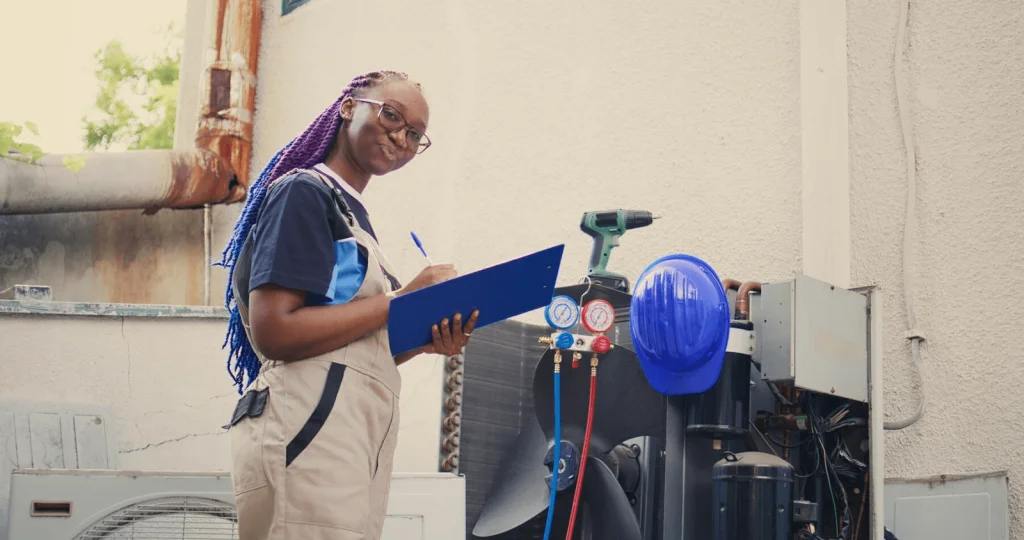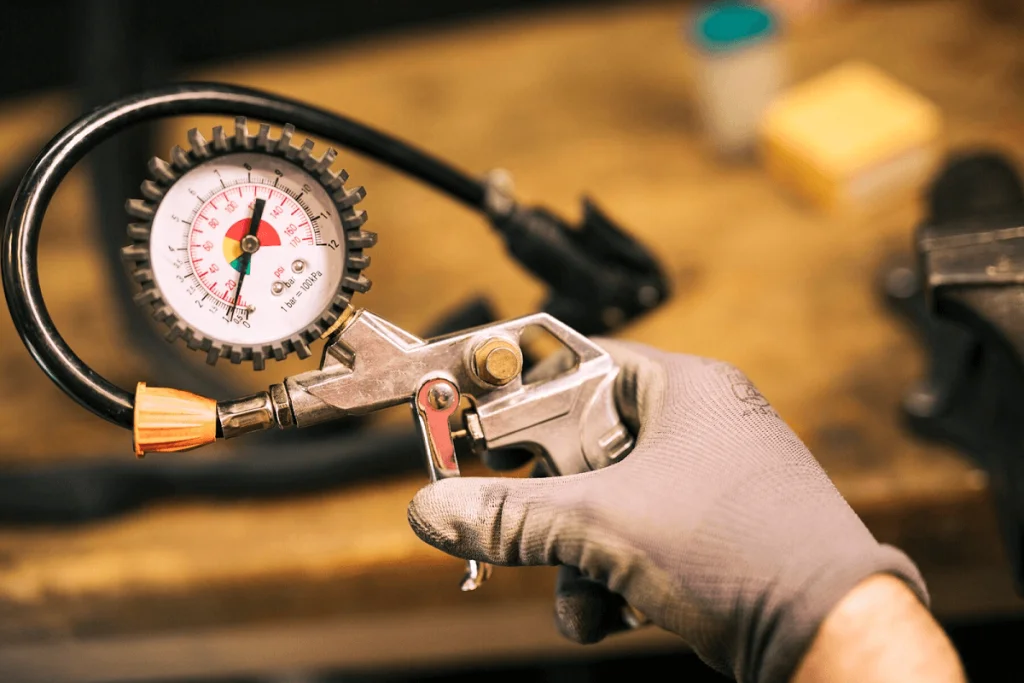It is always a common question that is usually asked, “How big should an air compressor be?” The question has evolved over the years because of the many uses of air compressors available in the market. These machines can be used across a wide range of applications in various fields. This means that you must get an appropriate size or variety of an air compressor for maximum effectiveness, safety standards, and economic efficiency.
Choosing the right air compressor out of hundreds available in the market can be pretty exhausting. This guide simplifies this process through a complete overview of the sizing of an air compressor. We will discuss the key factors to consider, look at different types of compressors, and show you where your specific needs lie.
Being one of the best-known brands, VEVOR designs a wide variety of air compressors to meet every requirement. We will also discuss VEVOR Air Compressors and why it is an ideal choice for you to use.
Table of contents
- Understanding the Fundamentals of Air Compressor Sizing
- How to Determine the Right Air Compressor Size for Your Needs
- What Air Compressor Do I Need?
- Calculating Your Air Compressor Requirements
- What to Look For Before Buying an Air Compressor
- VEVOR Air Compressors – The Right Size for Every Job
- FAQs About Air Compressor Sizing
Understanding the Fundamentals of Air Compressor Sizing

The size of air compression is not really related to the real dimensions of the compression machine. Instead, we’re primarily concerned with its power output and capacity.
What Factors Are Important in the Selection of the Size of the Air Compressor?
Three things you should watch out for include:
- CFM, or cubic feet per minute is the measurement for a compressor to output air per minute. A greater CFM rating allows for the simultaneous use of more air tools.
- The strength with which air is expelled can also be estimated in terms of pounds per square inch abbreviated as PSI. Different tools and applications require varying PSI levels.
- Tank Size: How long you can use tools before the compressor has to be refilled depends on the air tank’s capacity.
Together, these elements define an air compressor’s total capabilities. Different tasks necessitate different combinations of these specifications. For instance, in a push-to-inflate application (tires) you should aim for high PSI, and while CFM does still matter it matters less; conversely in airbrushing consistent airflow at large volume is of greater immediate importance than psi.
How to Determine the Right Air Compressor Size for Your Needs

Selecting the appropriate air compressor size is a crucial decision that relies on several things. In the large scheme of things, this process could be a little daunting to undertake, however can always split that into the main factors aligned best with your needs.
How Big of an Air Compressor Do I Need for Common Tasks?
Here are some examples of common tasks and their typical air compressor requirements:
- Tire Inflation: A small, portable compressor with approximately 2 CFM at 90 PSI is generally sufficient.
- Spray Painting: This application typically requires 6-9 CFM at 40 PSI for optimal performance.
- Pneumatic Tools (e.g., nail guns): These usually require about 2-5 CFM at 90 PSI.
- Impact Wrenches: Many of these instruments operate at 90 PSI 5-8 CFM, on a regular basis.
It is important to note that most of these figures are approximate numbers. For precise size, always consult your tools’ individual specifications.
Air Compressor: What Size Do I Need for Specific Applications?
For more precise guidance, consider the following list of common air tools and their typical requirements:
- Brad Nailer: 0.3 CFM at 90 PSI
- Framing nailer: 2.5 CFM at 90 PSI
- Drill: 90 PSI, 3-6 CFM
- Grinder: 4-6 CFM at 90 PSI
- Impact Wrench: 90 PSI, 2.5-10 CFM
- Paint Sprayer: 30–50 PSI at 6-7 CFM
Choosing the right size is important for efficiency as well as for fulfilling minimal criteria. An undersized compressor will make the air compressor turn on and off more often, this action wears it out early and efficiency decreases as well. But a compressor that is too large will also be costly. The search for an ideal balance of features that would sufficiently meet your needs is the ultimate goal.
Recommended For Your Project
What Air Compressor Do I Need?

There are quite a few different types of air compressors available, so each has its own range of uses. An understanding is also needed of where different air compressors are best used.
Choosing Between Portable and Stationary Air Compressors
Portable Compressors:
- Advantages: Mobility, suitable for DIY projects and small-scale applications
- Disadvantages: Generally less powerful, smaller tank size
- Optimal for: Home use, small workshops, on-site jobs
Stationary Compressors:
- Advantages: Higher power output, larger tank size, capacity to run multiple tools
- Disadvantages: Limited mobility due to weight
- Optimal for: Large workshops, industrial settings, continuous-use applications
Understanding the Difference Between Oil-Free and Oil-Lubricated Air Compressors
This looks at whether you need an oil-free or oil-lubricated air compression tool. First, let us understand the most basic difference between these 2 compressors
Oil-Free Compressors:
- Advantages: Low maintenance requirements, cleaner air output
- Disadvantages: Potentially higher noise levels, typically shorter lifespan
- Optimal for: Painting, food processing, medical applications
Oil-Lubricated Compressors:
- Advantages: Quieter operation, extended lifespan
- Disadvantages: Require regular oil changes, not suitable for applications requiring clean air
- Optimal for: Heavy-duty applications, industrial use
Calculating Your Air Compressor Requirements

To determine precisely “what size compressor do I need”, follow this step-by-step guide:
Step-by-Step Guide to Calculating CFM and PSI Needs
- Inventory Your Tools: Create a comprehensive list of all air tools you intend to use.
- Determine Individual Requirements: Research and note the CFM and PSI requirements for each tool.
- Assess Simultaneous Usage: If multiple tools will be used concurrently, sum their CFM requirements.
- Consider Duty Cycle: For continuous-use applications, add 25% to your calculated CFM requirement.
- Identify Maximum PSI: Select the highest PSI requirement from your tool inventory.
A commonly followed practice is to specify a compressor with a capacity of 20-30% more than the calculated capacity. This buffer ensures optimal performance and allows for potential future expansion of your air tool inventory.
What to Look For Before Buying an Air Compressor
In addition to size, there are other factors that will impact what the best air compressor is for you.
Power Source: Electric vs. Gas-Powered Compressors
Compressed air generation is generated in different ways, and this section will endeavor to provide an overview of electrically powered compressors and gas compressors.
Electric Compressors:
- Advantages: Lower noise levels, suitable for indoor use, reduced maintenance requirements
- Disadvantages: Limited portability, require access to electrical power
- Optimal for: Home workshops, indoor applications
Gas-Powered Compressors:
- Advantages: Higher power output, enhanced portability, suitable for outdoor use
- Disadvantages: Higher noise levels, require ventilation, need for fuel
- Optimal for: Construction sites, outdoor projects
How Big of an Air Compressor Do I Need for a Workshop?
For example, you may need to rent a huge air compressor if your workshop is larger and requires more power output or work type. Here are some basic groundrules:
- Small Workshop (DIY, hobbyist): 2-3 HP, 20-30 gallon tank
- Medium Workshop (small business, advanced DIY): 5-7.5 HP, 60-80 gallon tank
- Large Workshop (professional, industrial): 7.5-10+ HP, 80+ gallon tank
It’s generally advisable to select a compressor with slightly more capacity than your current needs to accommodate potential future expansion.
VEVOR Air Compressors – The Right Size for Every Job
Having covered the fundamentals of air compressor sizing, let’s examine why VEVOR air compressors are a suitable choice for various needs.
Why Choose VEVOR Air Compressors?
VEVOR offers a comprehensive range of air compressors to meet diverse requirements. Their products stand out for several reasons:
- Diverse Product Range: VEVOR provides options ranging from small portable compressors for home use to large stationary units for industrial applications.
- Quality Construction: VEVOR compressors are engineered for durability and reliable performance.
- Cost-Effectiveness: The quality and price of these compressors are balanced.
- User-Friendly Design: Nonetheless, all products at VEVOR are designed for easy usage and management even if the client has little knowledge about air compressors.
The Types of Air Compressors You Can Use if You’re a DIYer or a Professional
VEVOR caters to users across the spectrum:
- Light Use: Light spray painting, tiny pneumatic tool operation, and tire inflation are all applications for VEVOR’s portable air compressors.
- Medium-Duty Applications: Small commercial settings or home workshops are ideal for VEVOR’s mid-range compressors, which have 20–30 gallon tanks.
- Heavy-Duty Professional Use: Large stationary compressors from VEVOR, including tanks that hold more than 60 gallons, are ideal for high-volume workshops or industrial settings.
FAQs About Air Compressor Sizing
Let’s address some common inquiries regarding air compressor sizing:
Q: What size air compressor do I need to paint cars?
A: Automotive painting calls for a flow rate of 12 to 15 CFM at 90 PSI of compressor. This is usually presented in terms of at least a five-horsepower motor and a compressor tank of not less than sixty gallons. For this reason, it is so important that the air flow be constant, and unvarying in order to achieve the best result.
Q: How big air compressor do I need for impact tools?
A: Hand tools such as wrenches and others need 4-5 CFM at ninety PSI due to their impact designs. But if the airbrush is going to be used frequently or continuously, then the user will require a compressor with between 6-8 CFM at 90 PSI.
Q: I have a small home shop and want to purchase an air compressor. What size air compressor do I need for home use?
A: For domestic applications, where the compressor is being used in the home, one would require a 6-gallon tank combined with about 2-3 CFM at 90 PSI. This capacity can work in areas such as inflation of tires, operating a nail gun and using small caliber air tools. For the more serious DIY use, there is a compressor that gives 4-5 cubic feet per minute at ninety psi and a larger tank of 20-30 gallons.
Q: Air compressor – what size do I need for a small workshop?
A: For a small shop only, a compressor should be able to deliver 5-7 CFM at 90 PSI with a 30-60 gallon tank. This arrangement makes it possible for most readily available air tools to be run on the system and in many cases two tools at the same time.
Keep in mind that these are only recommendations. When choosing a compressor, always consult your tools’ particular specifications and take your usage habits into account.
Find the Right Air Compressor Size for Your Needs
In conclusion, choosing the right air compressor size requires carefully weighing a number of aspects, including:
- Tool Requirements: Understand the CFM and PSI needs of your specific tools.
- Future Planning: Consider not only current needs but potential future applications.
- Tank Capacity: A larger tank reduces cycling frequency, benefiting both the compressor and your workflow.
- Power Source: Depending on your region and intended use, pick from versions that run on gas or electricity.
- Compressor Type: Depending on your needs, choose between oil-free and oil-lubricated types, as well as portable and fixed variants.
Proper choice of an air compressor is a great investment in increased performance and reduced costs. It is not simply about being able to do the minimum and gain results, but it is about how your work process can be designed for enhanced results.
Now that you’ve gained such extensive knowledge about how air compressor sizing works, you have everything you need to consider when shopping for them with VEVOR. From the homeowner who occasionally uses pneumatic tools to the full-time carpenter or builder, we present air compressors perfect for you at VEVOR. The quality, the variety, and even their affordability just make them the perfect deal for anyone who wants an air compressor.
This information in the guide will help you to choose the right air compressor that best suits your requirements. Your future endeavors will surely benefit from your well-informed decision.





